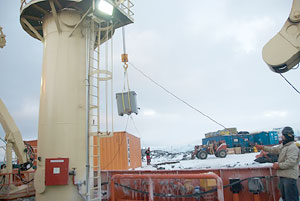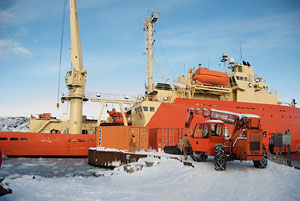

 | |||||||||||
|
|
Journals 2008/2009Megan O'Neill
April 29, 2009 As I woke up and looked out this morning, I saw the lights from Palmer Station. We had a smooth trip back through the Neumayer Channel and had made it back. At 8:00 a.m. we docked (an incredible feat to me that the Captain pulls it in to the dock with all the rocks around and narrow passage!) and began the unloading of the fish. Dr. Sidell has been working here in Antarctica over the past 20 and has all but perfected the transfer of the fish to the station from the ship with minimal stress on the fish. The fish are kept in the holding tanks from the ship (look like large, heavy duty, plastic bins with lids), hoisted by the crane with straps, set on the pier at Palmer Station, picked up by a fork lift and carried up to the lab building where Dr. Sidell and the other scientists use a stainless-steel, pallet jack to transfer the tank to the aquarium room rollup door where they use dip nets to transfer the fish to the aquarium room tanks. This method results in only one transfer of the fish to reduce stress and increase survival rates. All six were unloaded safely, but it was a little disconcerting to see the tanks lifted so high into the air with the fish for all the upcoming labs swaying to and fro! I can only imagine how this made the scientists stomachs churn until they were safely on the ground again! The whale tagging team started to board the ship as we unloaded. They will be going out for 12 days to start their research. They have a great blog site for their research experiences at www.nicholas.duke.edu/antarctica - I even have a “guest blog appearance” there, so check it out! At 1:30 we had our Palmer Station orientation to learn about operational procedures and to take a tour of the facilities. It is much nicer than I had expected – all the buildings are extremely well insulated and kept at a very comfortable temperature. Our rooms are the size of a typical dorm room with bunk beds and very nice shared bathrooms (women’s and men’s) on each hall. There is a great TV area with comfortable couches, a wonderful workout facility with treadmills, stationary bikes, weights, workout videos, recreational equipment for checkout and even a store for souvenirs. All kinds of great things! The “Bio” building is a walkway away and houses the science labs, the aquarium room, the galley (kitchen), offices and some other dorm rooms. It is all kept very nice and clean by everyone – because each Saturday everyone pitches in for “house mouse” and pulls tasks out of a hat for cleaning. Next we were taken on a tour of the galley by the head chef, Eric Cooper, a lab tour by the Lab Manager, Pat and the waste tour by Chris. Waste is an important thing to deal with when you consider that Palmer Station is a “closed system” and waste has to be hauled away. It is compacted as much as possible, separated (solid, recyclables, medical and lab wastes) and then loaded on containers that will eventually be shipped off before winter. Lots of jobs, tasks and teamwork involved in running Palmer Station! The community feeling is really nice and I understand why people like to continue returning to work here year after year! Next we had “Boating I” orientation with Ryan. This consists of preparing for using the zodiac boats available for research events and recreation. You have to complete Boating I to be able to get into the boats and “Boating II” to be able to operate the boats. We learned about safety issues such as the equipment located on each boat, concerns of weather in this area, radio contact and the emergency caches located on various locations. A map was also provided marking the boundaries of the areas to visit around Palmer Station and a dry bag to use for emergency clothes/equipment while on the boats.
|
||||||||||

